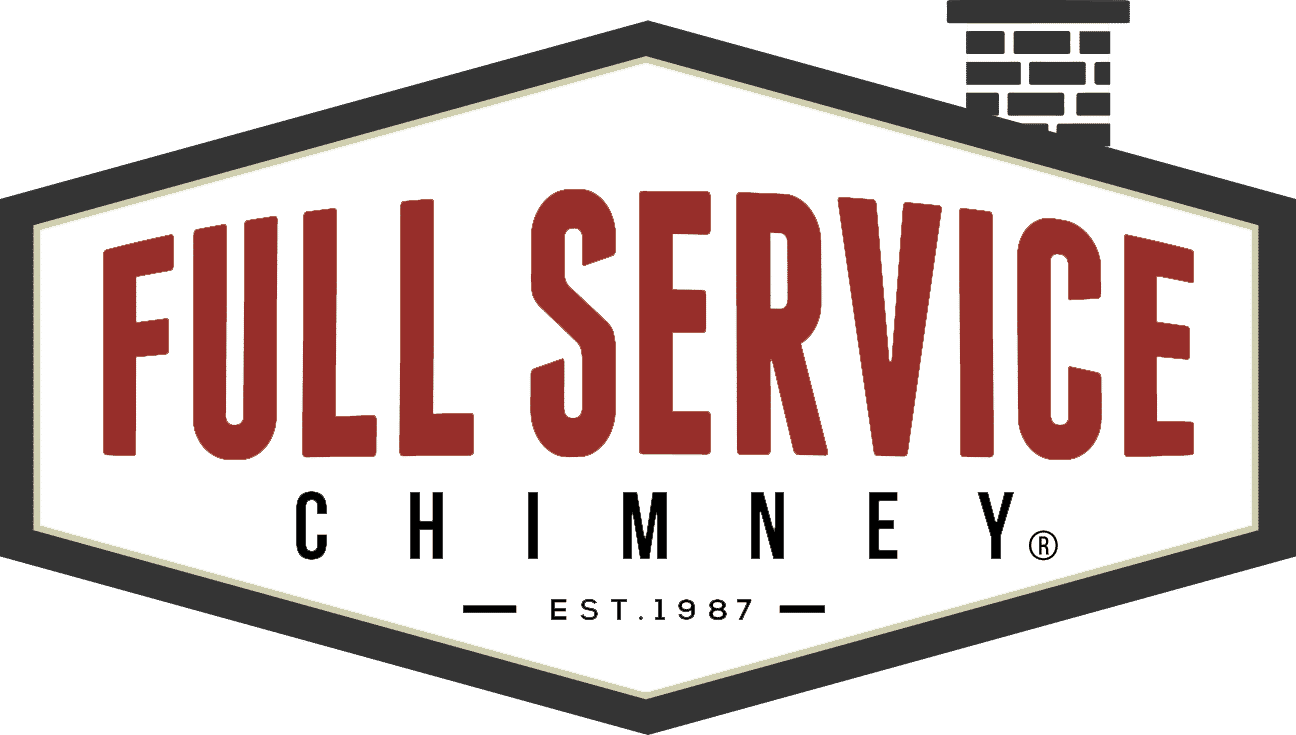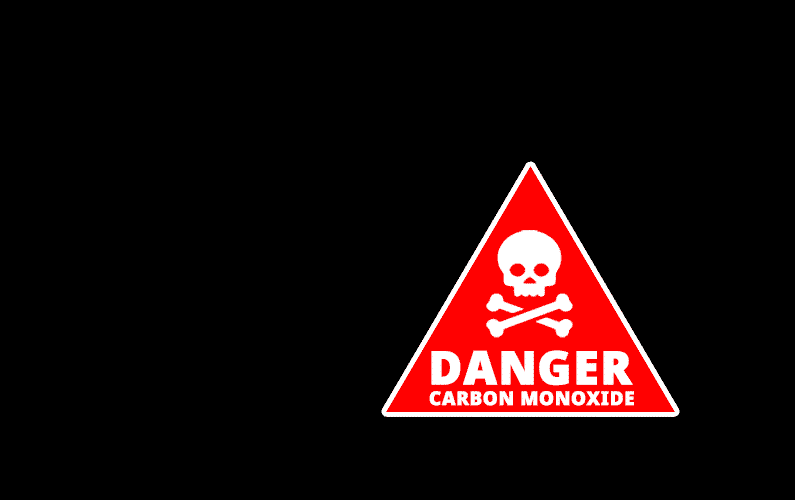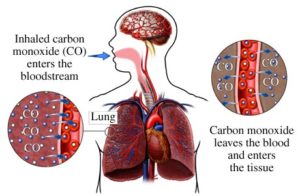If you have a fire or reason to suspect carbon monoxide is entering your home, get outside and call 911. DO NOT re-enter the home until the authorities have confirmed it’s safe to enter.
What is Carbon Monoxide (CO)? How does it happen and how can we stop it from happening in our homes? All essential questions but too often overlooked items on your home maintenance checklist.
Most people are aware of the dangers of gas appliances, but it usually comes as a surprise that fireplaces and chimneys are sources of carbon monoxide poisoning, also. That’s right chimneys can push carbon monoxide back inside the home! So it’s good practice to learn everything you can about how to keep unseen danger out of your house. Take steps to help keep your family safe from the invisible gas that is (CO) Carbon Monoxide. Read on to learn more…
Why is Carbon Monoxide called the Silent or Invisible Killer?
Over the years, this poisonous household gas has gotten a few nicknames. If you’re wondering why they call Carbon Monoxide (CO) the “Silent Killer” or the “Invisible Killer,” or as seen in the CDC Video the “Quiet Killer” the answer is in the name.
Video Transcript
00:00 [Music]
00:29
Siren wailing
00:31
WOMAN: 911. What’s your emergency?
00:33
WOMAN #2: Unit 21. Third and Lincoln.
00:35
Each year in the United States,
00:37
approximately 20,000 people go to the emergency room
00:40
for carbon monoxide poisoning.
00:41
Carbon monoxide is a colorless, odorless gas.
00:44
It’s extremely poisonous,
00:45
and it can kill you in minutes if you’re exposed to it.
00:48
Nearly 500 people die from carbon monoxide poisoning.
00:52
NARRATOR: Fire & Rescue Captain Antonio Burden
00:54
is a first responder
00:55
and has been a victim of a CO leak in his home.
00:58
It’s a strange feeling,
01:00
once you start, you know, feeling dizzy.
01:03
Then you get a tremendous headache.
01:06
Man!
01:07
You also start experiencing nausea
01:09
and that nausea can lead to other symptoms.
01:13
DR. GARBE: In a really severe case of carbon monoxide poisoning,
01:16
someone could lose consciousness or die within minutes.
01:19
NARRATOR: Hurricanes or severe storms
01:21
can trigger power outages that last for days.
01:23
Some people fire up a generator for power
01:26
or a gas stove to heat their home,
01:28
but fail to realize the danger.
01:30
It’s one thing to be cold.
01:31
It’s another thing to be seriously ill
01:33
and need critical care.
01:34
Never use your oven to heat your home.
01:37
It could be a source of carbon monoxide for you.
01:39
It’s dangerous. Don’t do it.
01:42
DR. YIP: Make sure that their appliances and heating devices
01:44
are properly vented and maintained by a professional.
01:47
Dangers from poorly maintained heating systems
01:50
are really going to be the number-one cause
01:53
of carbon monoxide poisonings in the United States.
01:55
DR. YIP: CDC suggests that generators be placed outdoors.
01:59
DR. GARBE: We recommend at least 25 feet away from your house.
02:02
The best is as far away from your home as possible,
02:06
so if your power cord is 50 feet,
02:09
I would put my generator 50 feet away from my house
02:11
if I was using it.
02:12
NARRATOR: There are actions to protect your family.
02:14
DR. GARBE: CDC recommends that all homes have carbon monoxide detectors.
02:18
I think it’s a great investment.
02:20
It’s particularly important
02:21
that you have carbon monoxide detectors
02:23
near where people sleep at night.
02:25
The worst location for a carbon monoxide detector
02:28
is in the box without a battery.
02:31
Most importantly, when you go to purchase a CO detector,
02:33
make sure that it is specifically for carbon monoxide.
02:37
DR. GARBE: The other important thing is that it’s battery-operated.
02:40
If it is an A.C.-operated detector,
02:42
it’s important that it also have a battery backup.
02:45
Running your car in the garage,
02:47
even with the garage door open, is not safe.
02:49
DR. GARBE: If you have to get your car warmed up in the wintertime,
02:52
make sure it’s parked in the driveway
02:54
well away from the house.
02:55
Carbon monoxide makes people sick.
02:58
It kills people, and it’s completely preventable.
Carbon Monoxide is dangerous because it does not rise or sink, and it’s lighter than air. CO blends into the existing air, it cannot be seen, heard, touched, or tasted and is lethal without the aid of a device to detect its presence.
Carbon monoxide molecules are so tiny that they can travel straight through drywall!
CO is a naturally occurring gas that can be lethal since it’s odorless, colorless, tasteless, and there are often no symptoms to alert us to problems happening inside the body, until it’s too late.
It’s a bleak topic we all must stop to consider for the sake of our families and home safety. Although it’s unpleasant to think about, the consequences are real and should never be underestimated.
Fireplaces can be a risk to your home | Here’s what you need to know about C.O.
If you have a fireplace and chimney, then you MUST watch the video.
One of our chimney sweeps shot this footage from a customer’s roof, and he explains how it relates to carbon monoxide. What you’re looking at may not be evident at first, but what you’re seeing shows one way how chimneys can push carbon monoxide back inside a house.
Video Transcript
“So, one of the common things we hear our customers say, and when it comes to their heating or the heating of the water in their home with their utilities that vent into the chimney you know, if something goes wrong, I have carbon monoxide detectors. Those will tell me, you know, if there’s a blockage in my flue, or if something’s going on, that could be poisoning me, this is just a prime example of how that’s just not completely accurate.
So in this case, we have a furnace being vented into this chimney, of course it’s falling apart, but that’s not even the worst of it.
The bricks, which should be either around the chimney or maybe fallen off.
They’re not on the ground…
They’re right there.
The furnace is currently being vented into this area and it’s completely blocked.
See if I can show you, it looks like there’s a little bit of exhaust coming out, but for a 110,000 BTU appliance this is definitely putting that exhaust back into the home.”
Here at Full Service Chimney™, we specialize in everything related to chimneys and fireplaces, including your venting for gas water heaters and gas-powered furnaces. When it comes to chimney flues, a Certified Technician can help you verify your systems ventilation pathways, aka chimneys, are cleared of any debris or other blockages, such as witnessed in the shocking video.
If you’ve watched the video, and the message was not clear, let us further explain:
Old bricks from the masonry chimney collapsed then got stuck inside the top of the chimney, blocking the pathway that exhausts the smoke and toxins from the fires burning below. Oxygen, smoke, and natural gases, like CO, are meant to pass through this opening. If the smoke cannot safely escape the chimney, then the carbon monoxide created has nowhere else to go but back inside your home.
Most people will have no pre-warning and never know it happened since blockages (as seen in the video) are not viewable inside the house or fireplace; even looking up inside your chimney, you’re unlikely to see a blockage this high up in the structure.
Imagine for a moment that was your home in the video. It’s a chilly night, you’re on holiday enjoying a cozy fire in the family room, and all is well in the world. Except for the blocked chimney that nobody knows is pushing carbon monoxide and other toxins back down the flue and into the same room where you’re relaxing with the family. If it’s smoky, everyone will likely notice and leave; but since carbon monoxide is undetectable, and will not alert anyone of its presence until it’s too late. By this time, people are dizzy and feeling sick. That’s a dreadful thought, but it happens all the time.
Over 430 people die every year in the United States due to unintentional carbon monoxide poisoning. And approximately 50,000 people are hospitalized due to accidental CO poisoning. | Source: CDC
Please make no mistake; what you witnessed in the video was a seriously deadly situation. Still, it is also preventable with annual inspections and regular maintenance to your chimneys and other household appliances that require regular servicing.
Can Household Appliances Cause Carbon Monoxide Poisoning?
Yes. Any fuel-burning appliance will produce carbon monoxide and must be vented properly to remove exhaust from your home. Otherwise, people in the home can become very sick or worse, suffer a fatality.
You’ve probably heard warnings to never leave your car running in the garage, and that’s good advice. Even with the door open, you’d risk poisoning yourself or anyone inside the car and house. (Remember, CO molecules can still seep through the walls and other openings in your home.)
Some Causes of Carbon Monoxide Poisoning in Homes
The most common sources of carbon monoxide are household appliances and other types of equipment that burn fuel. Anything that burns coal, oil, kerosene, charcoal, wood, or gas will produce CO and must be properly exhausted outdoors.
People often associate CO with only gas-burning devices, but wood or coal-burning appliances can also push this deadly toxin into your house!
WARNING:
If you have a fireplace DO NOT immediately shut your damper after a burn! The fumes and exhaust need time to air out and leave the flue. Shutting it too soon can push carbon monoxde back inside your home and living spaces!
Learn more about how to operate fireplace on our article all about chimney dampers.
Household Appliances that Produce Carbon Monoxide
This list does not cover every potential source of carbon monoxide poisoning; however, these are some primary CO producing appliances found in most older to modern-day homes:
- Chimneys
- Gas Furnaces
- Water Heaters
- Clothes Dryers
- Gas Stoves/Ovens
- Wood Stoves
- Boilers
- Fireplaces
Every item on the list is safe to use when properly installed and maintained as recommended by your manufacturer’s label or manual.
Other Regular Household Equipment that are sources of CO:
- Generators
- Space Heaters
- Automobiles/Motor Vehicles
- Power Tools
- Lawn Equipment
- Camping Supplies (i.e., Grills/Lanterns/Lamps, etc.)
To ensure safe living conditions, schedule annual maintenance with the appropriate local professionals to keep your systems running efficiently year-round.
Learn how to prevent carbon monoxide poisoning with this helpful CDC Video.
How to Detect Carbon Monoxide?
To detect this lethal gas in your home or other indoor property, you need to install a carbon monoxide detector. Like smoke alarms, any time you move into a new home, you must verify that you have a working alarm system to detect carbon monoxide. When equipped with fresh batteries, some of these detector alarms can last many years.
While this is one beep we never hope to hear, it’s also a sound that could save lives! That’s why these detectors, once installed, should be checked and tested regularly to make sure the beep will sound loud and clear if it ever detects carbon monoxide in your home.
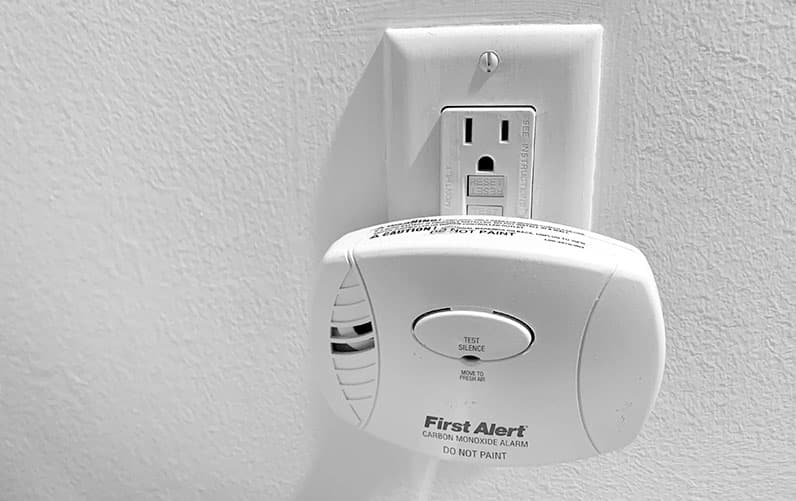
Example: a plug-in style CO Alarm should always have a battery backup in case the power goes out. If you lose electricity you’ll be confident the detector system is still working.
What are the Symptoms of CO Poisoning?
The first signs could be mild to increasingly severe headaches and fatigue to feeling dizzy and nauseous. Chest pains and an increasingly rapid heartbeat are possible, combined with flu-like symptoms.
- dizziness
- nausea
- upset stomach
- headaches
- fatigue
- rapid heartbeat
- chest pains
- confusion
- losing consciousness
If everyone in your home experiences flu symptoms while inside the home (minus the fever, body aches, or swollen lymph nodes) but feels better upon leaving the house, then a CO leak could be the reason. Infants, pets, the elderly, or people with already weakened immune systems may be affected sooner than healthy adults.
Recorded cases for carbon monoxide poisoning increase during the winter months:
The months with the most reported cases of CO Poisoning are December, January, and February
Due to power outages and increased usage of gas-powered generators, the CDC advises people to make sure to keep the generators downwind at least 20 feet from the house or any openings.
Warning Signs a CO Leakage in your Home Appliances, Fireplaces, and Chimneys
Carbon Monoxide is undetectable without a calibrated instrument to measure CO levels. Without a proper detection system in place, it is challenging to determine the presence of carbon monoxide.
The root cause of CO problems is much more complex than people realize and often requires a team of trained professionals. If you have gas appliances in your home, then advanced planning is your safest bet. Use your community resources ahead of time to know who to call in the event of a gas-related issue.
When in doubt, call 911. In this case, you’re better safe than sorry!
If you have any reason to believe you have a CO leak and anyone in your home (including pets) is experiencing physical symptoms, then you need to leave the house to seek immediate medical assistance.
If there are no physical, health-related symptoms but you do notice any of the following, then there is a big cause for concern.
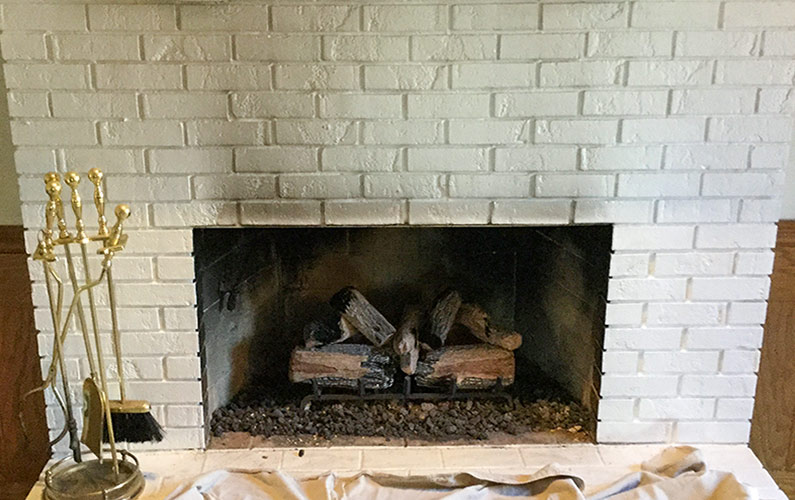
Soot above your fireplace is a bad sign! Learn more about what this black stain could mean.
Here are a few household warning signs to watch out for that could alert you to a carbon monoxide problem:
Fireplace Signals of Carbon Monoxide Problems
- Sooty black marks or smoky stains above your fireplace or yellowish-brown stains on your gas appliance.
- If there is no upward draft in your fireplace.
- Fallen soot or creosote on the floor of your firebox.
- Stale or stuffy air that smells like something is overheating.
- If your fires are burning much slower than usual, that could signal CO issues.
Get a more in-depth lesson on Fireplace Backdrafting Problems.
Gas Appliances and Pilot Light Warning Signs
PLEASE NOTE: This section is NOT about fireplaces, but rather utility appliances that have a pilot light.
*If you have a natural gas fireplace that burns an aesthetically pleasing yellow flame, this is not the same as a pilot light, and there’s no need for concern. In this case the system intentionally produces a visually pleasant experience. We recommend always reading your manufacturer’s labels and instruction manuals to familiarize yourself with the requirements of all gas-burning appliances in your residence. Learn more about the different types of fireplaces.
Read on to learn more about Gas Pilot Lights, starting with a warning and what you need to know if your home has any sort of appliance that uses a pilot light.

Image shows what the top of a standard water heater in your home looks like.
Check Your Utility Chimneys
Look on top of your gas water heater for rust, paint discoloration, and debris. These are clues of a back-drafting problem and evidence of flue gas spillage. Make sure you have a CO detector installed to give you a more immediate warning of this problem.
Check for Moisture Around your Appliances
If your gas appliance shows signs of excess condensation, like dripping water, you’ll want to determine the cause as soon as possible and fix the problem. While it’s possible it’s a humidity issue; there is always a chance it’s a carbon monoxide leak.
Any of these are warnings of a possible carbon monoxide leak and a signal that you’re past due for a professional examination.
Warning: Your pilot lights should always burn blue.
If your Pilot lights are constantly going out and need relighting or are burning yellow, then it needs attention NOW, not later!
If your pilot light is yellow or red, turn off your heating system and call your gas plumber for immediate service. Any pilot light color that isn’t blue means some other substance is mixing with the methane gas. While it could be dirt, oil, rust, or excess air, your pilot light flame being any color that isn’t blue is a warning sign of carbon monoxide.

Example of a water heater in your home.
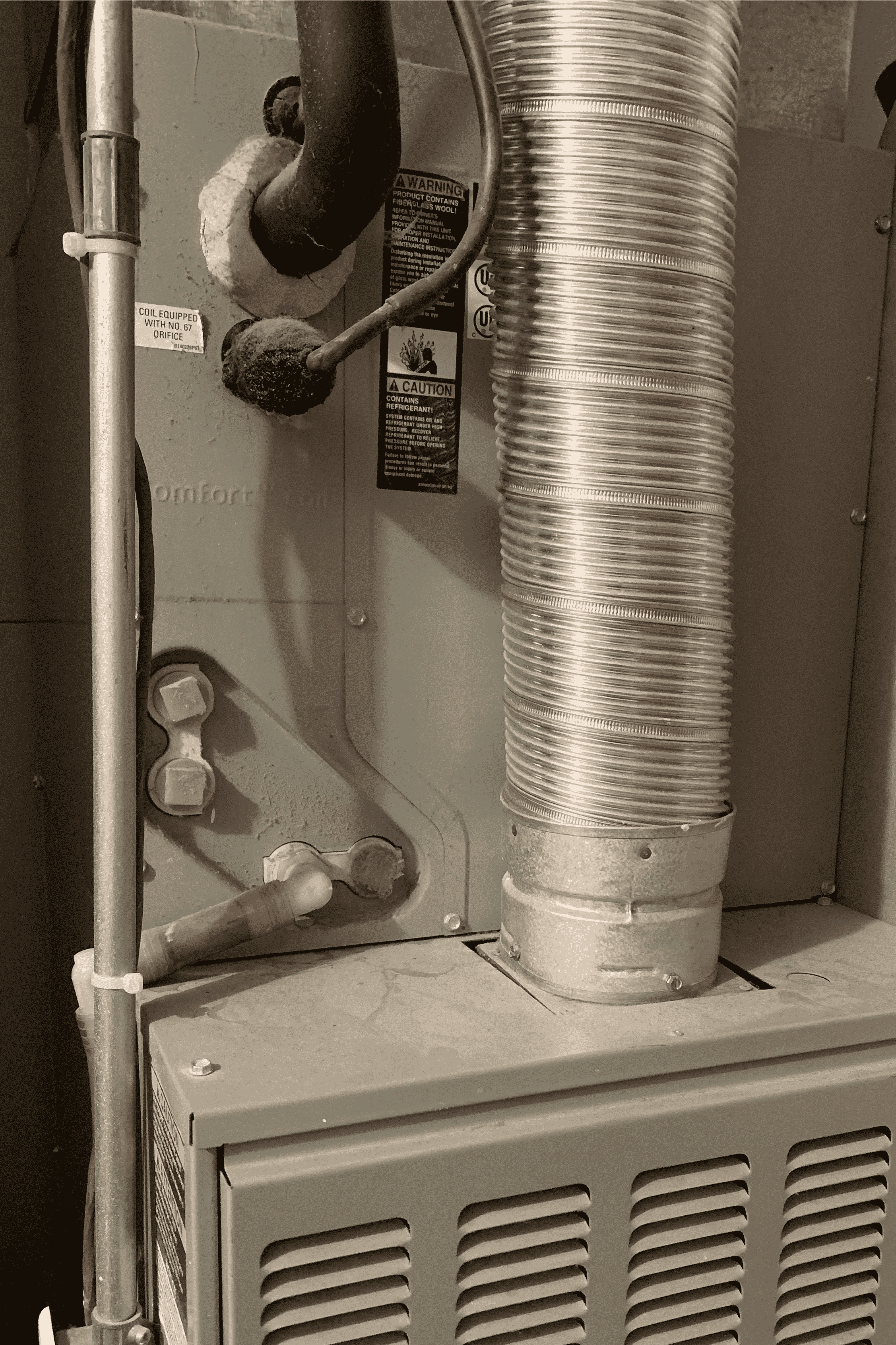
Example of a furnace in your home.
Prevent CO Build-up in Your Gas Appliances
Carbon monoxide is naturally produced whenever you or anyone burns fossil fuels.
When a gas appliance functions correctly, its carbon monoxide vents outside the home. This is the ideal scenario for every resident in every home. You can make sure your system vents CO properly by keeping up on regular appliance maintenance for all the gas-burning appliances in your house, including gas water heaters and furnaces, fireplaces, motorized devices, or any other equipment you own that uses fossil fuel for power.
Learn more about our Gas Chimney Services.
The Cost to Install a Detector
With many options to choose from, the average cost of a carbon monoxide detector falls somewhere between $35-$150 for one stand-alone unit. Or up to $880+ for a system that may combine other features with smoke and CO detection. These are sometimes even included with some home security systems! The total price depends on many factors, primarily the needs of your residence.
Some communities offer free fire/smoke alarms and carbon monoxide detectors, possibly even with installation services. We recommend contacting your city or county offices for local resources that may be available in your area.
What about Carbon Monoxide Detectors in rental properties?
If you rent your home, talk to your landlord and check your lease/rental agreement for details on the policy for smoke alarms/carbon monoxide detectors. This will vary by your individual situation.
Few states require landlords to provide detection systems in newly constructed residences or in any dwelling that has a source of CO. It is not a legal requirement in most states, and the responsibility rests on your shoulders to find the details and use the resources available in your community.
SUMMARY: Annual Inspections are Non-Negotiable
If you’re concerned with keeping your home safe and sound, then annual chimney inspections are non-negotiable. When you ask questions, what you can learn from a CSIA Certified Technician during your appointment could save your life.
If you’re in the Kansas City area, we can help prevent this poisonous situation from happening to you. Call us at 913-642-6171, and together, let’s make sure your fireplace is ready for safe burning, and your gas appliances are installed properly to ventilate those harmful toxins to the outdoors where they belong!
If you live outside the KC Metro, then the Chimney Safety Institute of America (CSIA) has plenty of homeowner resources and can help you find a certified chimney sweep in your area.
Read more information on Avoiding Carbon Monoxide.
*This is a revised article from an original publish October 18, 2018
Disclaimer:
The information on this post is for educational purposes only. If you have a fire or reason to suspect carbon monoxide is entering your home, get outside and call 911. DO NOT re-enter the home until the authorities have confirmed it’s safe to enter. Then contact a service professional in your area for any necessary repair work to prevent Carbon Monoxide problems.
Our trained technicians identify, troubleshoot, and help solve CO problems with certain appliances like gas utility flues such as water heaters and furnace chimneys and fireplace ventilation systems/flue relining and complete rebuilds. However, depending on the situation, you may still need to contact other HVAC or Plumbing repair professionals. Once your home is safe to enter we can do a chimney inspection.
